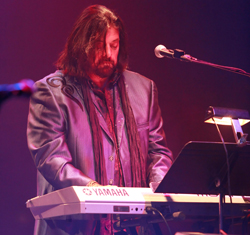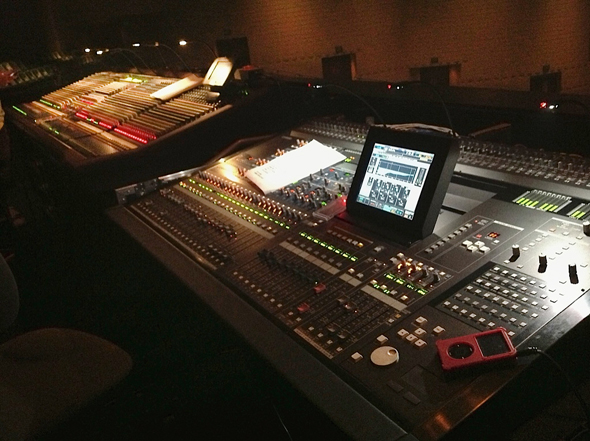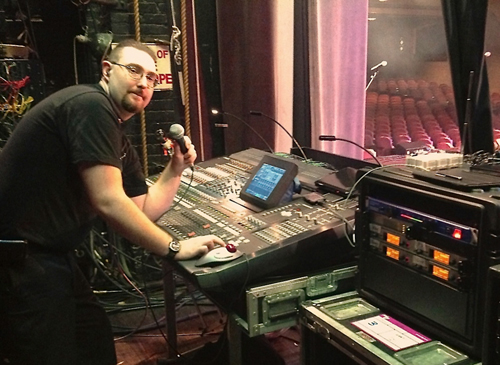
“The Optogates work well, and although we could probably make more use of them, if you open up an Optogate, it does change the sound,” Parsons notes. “Manually, you can ease the mic in. When the Optogate kicks in, you’re hearing drums, for instance, on that vocal mic, so it can be problematic. I think we’ve kept it under control, but if you had the whole band on Optogates, the sound would change constantly.”
Similar To Symphony
Frey’s preferred touring house system includes EAW Red Certified KF740 line arrays, which he endorses based on the performance of the loudspeakers and the tool kit that accompanies the system. This includes Resolution array design and modeling software, Greybox DSP settings with EAW Pilot in DSP-capable amplifiers housed in Powercube racks and use of Powertools for on-site system optimization.
While that package wasn’t feasible this time out, Frey says he was still able to achieve consistent sound relatively easily at each tour stop. It helps that the band members have substantial experience as both live performers and studio musicians. “Not only do they know a lot about sound, but they know a lot about their own sound,” he observes. “Again, my whole approach to mixing this show is much like that Alan took in the studio, and musically, this show has a huge dynamic range.
“For example, the song Sirius, which starts with huge drums and guitars, comes down to almost nothing, segues into Eye In The Sky, and then ramps up again to the chorus and those seven-part harmonies. It’s very similar to the dynamic range of a symphony performance.”
Like Frey, monitor engineer Dunn encountered a variety of consoles on tour, but in the U.S. he had the luxury of using the same Yamaha PM5D at six shows. “That’s his preferred workflow environment,” Frey says, “but I’ve seen him mix on just about everything and we both have show files for virtually every desk.”
Dunn supplied seven in-ear mixes for the band via Sennheiser ew 300 IEM G3 systems. Parsons sported ACS T1 Live triple-driver ear monitors, with the band on a mixture of Future Sonics Atrio and Shure SE425 earphones (the latter for lead vocalist PJ Olsson and drummer Thompson). Dunn also developed mixes for wedges and side fill, kept at low volume, and a mix for two wedges and a sub for Thompson.
“A monitor engineer’s job is a performance, every bit as much as a front of house engineer’s job is a performance,” Parsons notes. “The quality of the playing and dynamics are, to a certain extent, affected by what we hear, so the monitor engineer is every bit as important as the house engineer to most bands. The mix we hear is an inspiration. If it isn’t right, it’s counterproductive.”
For a show at Ruth Eckerd Hall in Clearwater, FL, APLP was joined on stage by a 29-piece orchestra. “The band’s stage sound isn’t loud to begin with, which helps, but the challenge was bringing those additional mics into the mix in front of a pop/rock band,” Frey says.

The 16-piece string section was close miked with ATM350 condensers, with dynamic mics deployed for section miking of the brass and horns. Additional instruments included tympani, woodwind soloists, English horn and vibraphone/xylophone.
He mixed the orchestra on a Midas Heritage 3000 console, sending stereo and mono stems from it to a Yamaha PM5D. “I just turned up the gain on each input on the H3000, engaged the high-pass filter as required, and brought the faders up to achieve the correct balance and sub-mixed strings, horns, percussion and solo instruments into the PM5D,” Frey details. “Everything was flat, no EQ whatsoever. Again, that was a benefit of the flat response of the condenser microphones and their accuracy in picking up the acoustic sound of the instruments, which, really, is the same way you’d record a symphony.”
While there are obviously differences between mixing a live show and in a studio, Parsons concludes, there are commonalities as well. “At the end of the day it’s about balance, and the way you achieve a good balance is similar. You’re more likely to use noise gates live, if you’re constantly fighting separation issues, and with live there are feedback issues you don’t normally experience in the studio. But other than that it’s a channel per instrument, pushing faders up and down, and making it sound pleasing to the ear.”
Based in Toronto, Kevin Young is a freelance music and tech writer, professional musician and composer.

